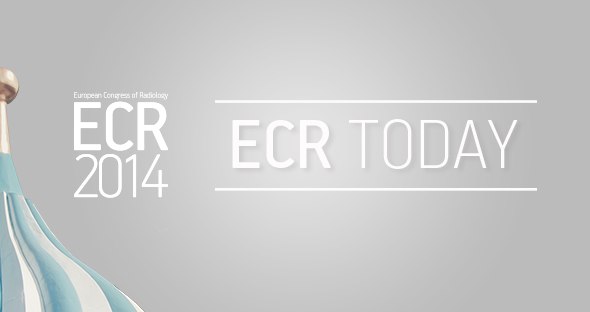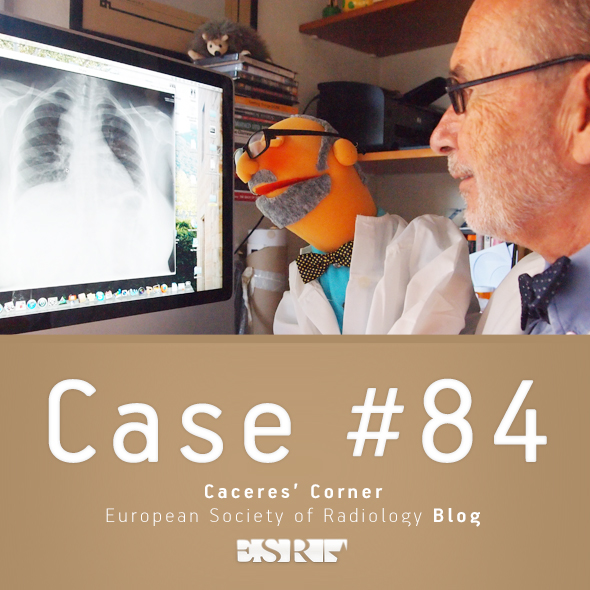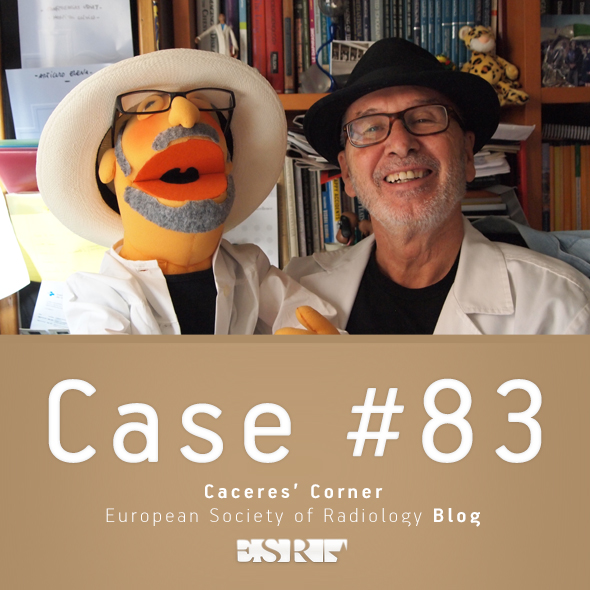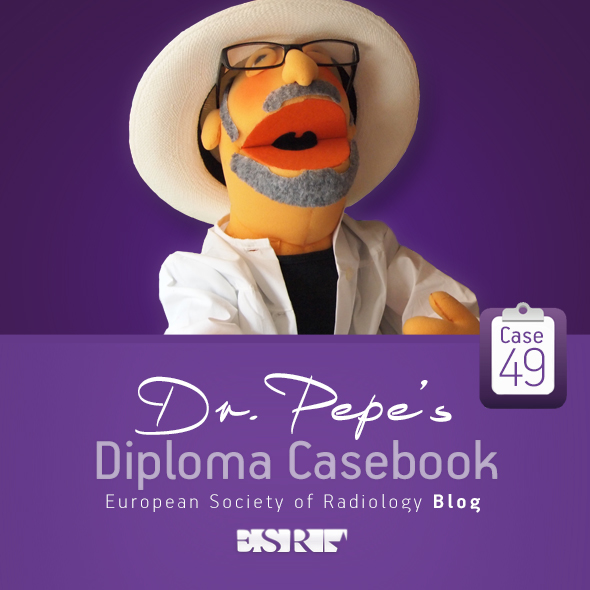
B-0801 Treatment response assessment in Hodgkin lymphoma: in search for morphological correlates of metabolic activity
T. Knogler, G. Karanikas, M. Weber, K. El-Rabadi, M.E. Mayerhoefer | Monday, March 11, 10:30 – 12:00 / Room F1
Purpose: To predict early treatment response with three-dimensional texture features (TF) in patients with Hodgkin lymphoma (HL) after radio-chemotherapy extracted from contrast-enhanced CT.
Methods and Materials: 21 patients with histologically proven HL were included in this study. Contrast-enhanced (18)F-FDG PET/CT was obtained on a dedicated PET/CT scanner. Volumes-of-interest and long- and short-axis diameter were manually defined on 48 HL manifestations prior and post-radio-chemotherapy on the CT image stack. Three-dimensional texture features derived from the grey-level histogram, co-occurrence matrix, run-length matrix and absolute gradient were calculated for the VOIs. A stepwise logistic regression with forward selection was performed to find classic radiologic features (i.e. lesion diameter, lesion volume) and TF, which correctly classify treatment response (i.e. full response and partial response). Classification in PET/CT was used as reference.
Results: Difference in short axis diameter best fit as classic feature with a sensitivity of 100 %, a specificity of 54,5% and an accuracy of 89,6%. Combination of “S_0_0_1_Entrp” and difference of “vertl_fraction” best fit as TF with a sensitivity of 97,3%, a specificity of 72,7% and an accuracy of 91,7%.
Conclusion: Texture features extracted from contrast-enhanced CT in patients with HL are superior in differentiation between responders and non-responders without the need for PET examinations, compared to classical radiological features. However, PET/CT as state-of-the-art imaging technique has a sensitivity and specificity >90%, so that further research with larger patient number is needed to investigate this new method.

At each ECR since 2008, the ‘ESR meets’ programme has included a partner discipline along with the three guest countries, as a way to build formal bridges between the European Society of Radiology (ESR) and other branches of medicine, and to give congress participants an opportunity to learn about something a little different. At ECR 2014 the programme includes a visit from undoubtedly the largest medical discipline to take part in the initiative so far: cardiology, represented by one of the biggest medical societies in Europe, the European Society of Cardiology (ESC). Cardiology has much in common with radiology, but this is the first time that the two European societies have come together for an official joint session at a major meeting.
Despite some well-known points of controversy between the two disciplines, concerning professional ‘turf’, the overriding message during this afternoon’s ‘ESR meets ESC’ session will be one of cooperation and mutual understanding. Prof. Panos Vardas, president of the European Society of Cardiology, who will co-preside at the session, believes that the blurring of borders between subspecialties makes this kind of exchange of knowledge a must.
Read more…

A-445 Biliary procedures
M. Krokidis, A.A. Hatzidakis | Sunday, March 10, 14:00 – 15:30 / Room F1
Palliative Percutaneous Transhepatic Biliary Drainage (PTBD) is a therapeutic procedure leading to drainage of the obstructed bile duct system. If endoscopy is not possible and if patient is inoperable, then the percutaneous treatment is indicated. Drainage of the bile ducts is performed with a small plastic multiple hole pigtail catheter. Self-locking catheters are preferred in order to minimize the dislocation risk. The percutaneous catheter is pushed through the malignant stricture, so that bile is draining through the catheter towards the bowel loops. Technical success rate of percutaneous biliary drainage can reach nearly 100 % in experienced hands, while the major complications rate is usually lower than 5 %. Clinical efficacy is usually lower, but still over 90 %. The drainage procedure can be extended with the placement of a permanent metallic stent, which keeps the stenosed biliary duct patent, without need for a catheter. Metallic biliary stents have been proved as the best palliative treatment of non-resectable malignant obstructive jaundice, allowing longer patency rates than plastic endoprostheses. The technique is safe, with low-complication rate and procedure-related mortality between 0.8 and 3.4%. Still controversial remains in the timing between initial drainage and metallic stent placement, as well as the question of balloon dilatation before stent insertion. There is evidence that if the initial transhepatic drainage is completed without causing any severe complications, especially bleeding in form of haemobilia, primary metallic stenting can follow as a single-step procedure.

Dear Friends,
Dr. Pepe is still in Mexico, drinking tequila and enjoying mexican hospitality. He refuses to come back and asked me to cover for him. Radiographs belong to a 59-year-old male with fever. Had a similar episode two years ago which cleared with antibiotics.
Diagnosis:
1. Reactivation TB
2. Pneumonia
3. Carcinoma
4. None of the above
Read more…

B-0829 Feasibility of abdominal diffusion Kurtosis imaging compared to standard diffusion weighted imaging at 1.5 and 3 Tesla
H. Haubenreisser, J. Hansmann, A. Lemke, J. Wambsganss, S.O. Schönberg, U. Attenberger | Monday, March 11, 10:30 – 12:00 / Room I/K
Purpose: To demonstrate the feasibility of diffusion kurtosis imaging (DKI) for the depiction and differentiation of liver and kidney abnormalities in comparison to standard diffusion weighted imaging (DWI) at 1.5 and 3 T.
Methods and Materials: 109 consecutive patients underwent a routine abdominal MR protocol including standard DWI and DKI. 1.5 and 3 T b-values for DKI were identical: b=0-100-500-1000-1500-2000 s/mm². 55 liver and 36 kidney lesions were evaluated at 1.5 T, and 16 liver and 11 kidney lesions, respectively, at 3 T. DKI was assessed by an in-house built software. Kurtosis values were quantified by region-of-interest analysis and compared between lesions and normal parenchyma by a Wilcoxon rank sum test.
Results: Mean kidney kurtosis values were identical at 1.5 and 3 T in normal parenchyma (K=0.5) and cysts (K=0.4). Differences dependent on field strength were only found in malignant tumours (0.8 vs 0.5). At 1.5 as well as 3 T, cysts, tumours and normal kidney parenchyma could be differentiated with significance (p<0.0413) using the kurtosis values. At both field strengths, cysts, benign and malignant liver tumours could be differentiated with statistical significance from normal parenchyma (p<0.001, p<0.0071, p<0.001). However, malignant and benign liver tumours were significantly different at 1.5 T (p=0.0382). Abnormalities and normal parenchyma could be visually differentiated on both, DWI and DKI.
Conclusion: DKI of kidney and liver abnormalities is feasible at both, 1.5 and 3 T and allows for a quantified differentiation between normal parenchyma and pathologic lesions.

B-0962 First experiences with a self-test for Dutch breast screening radiologists as a quality assurance tool
J. Timmers, A. Verbeek, R. Pijnappel, M. Broeders, G. den Heeten | Monday, March 11, 14:00 – 15:30 / Room F2
Purpose: To evaluate the use of a self-test as a quality assurance tool for screening radiologists in the Dutch breast cancer screening programme.
Methods and Materials: 144 screening radiologists were invited to voluntarily complete a test set of 60 screening mammograms. The following grading criteria were assigned regarding the most suspicious lesion: location, level of suspicion, BI-RADS, laterality, type (well defined mass, ill defined mass, spiculated mass, microcalcification clusters, architectural distortion and asymmetric density) and mammographic density are assigned. Also, several reader characteristics, such as years of experience and number of cases read per year, were to be completed. Case and lesion sensitivity and specificity were determined for all readers. The spearman correlation coefficient was used to determine correlation between reader characteristics and performance measured by the area under the receiver operator characteristics (ROC) curve (AUC).
Results: 112 radiologists completed the test set (78%). The mean age was 49 (range 33-68) and on radiologists read on average 10,000 (range 700-60,000) screening mammograms per year. The median AUC value was 0.91, case sensitivity 91 %, lesion sensitivity was 91 % and specificity 94 %. The AUC was not correlated to reader characteristics. The test-set revealed interobserver variation in assigning lesion types.
Conclusion: Overall, a good performance was seen among all screening radiologists. Readers are able to determine their educational needs and compare it with peers during training or audits. It is therefore a useful quality assurance tool. Medical education should be dedicated to reducing interobserver variation.

Dear Friends,
Muppet and I are going to Mexico for a week. When back, we expect all of you to have clinched the diagnosis of this 58-year-old male with chest pain.
Leave your thoughts and diagnosis in the comments section below and come back on Friday for the answer.
Diagnosis:
1. Metastatic disease
2. Pulmonary infarct
3. Mesothelioma
4. None of the above
Read more…

Dear friends,
Today I am presenting radiographs and CT of a 27-year-old male with fever and malaise. Leave me your thoughts and diagnosis in the comments section and come back on Friday for the answer.
Diagnosis:
1. Teratoma
2. Thymoma
3. Lymphoma
4. None of the above
Read more…

Dear Friends,
Since I am an old codger, I am only allowed to look at pre-op chest films. As one young member of staff told me: you may be better than us, but we are faster because we read all of them as normal!
Today I am showing two pre-op chests. Would you read them as normal? If not, what do you see? Leave your comments below and come back for the answer on Friday.
Read more…

Dear Friends,
The first case of 2014 belongs to a 40-year-old male with a mild cough. What would you suspect?
1. Tuberculosis
2. Carcinoma
3. Enlarged left pulmonary artery
4. None of the above
Check out the images below and leave your thoughts and diagnosis in the comments section.
Read more…









